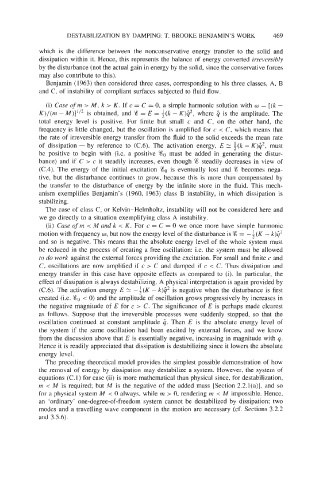Page 499 - Fluid-Structure Interactions Slender Structure and Axial Flow (Volume 1)
P. 499
DESTABILIZATION BY DAMPING: T. BROOKE BENJAMIN’S WORK 469
which is the difference between the nonconservative energy transfer to the solid and
dissipation within it. Hence, this represents the balance of energy converted irreversibly
by the disturbance (not the actual gain in energy by the solid, since the conservative forces
may also contribute to this).
Benjamin (1963) then considered three cases, corresponding to his three classes, A, B
and C, of instability of compliant surfaces subjected to fluid flow.
(i) Case of rn > M, k > K. If c = C = 0, a simple harmonic solution with w = [(k -
K)/(rn - M)]’” is obtained, and % = E = i(k - K)G2, where 4 is the amplitude. The
total energy level is positive. For finite but small c and C, on the other hand, the
frequency is little changed, but the oscillation is amplified for c < C, which means that
the rate of irreversible energy transfer from the fluid to the solid exceeds the mean rate
of dissipation - by reference to (C.6). The activation energy, E 2: i(k - K)G2, must
be positive to begin with (i.e. a positive %O must be added in generating the distur-
bance) and if C > c it steadily increases, even though 8 steadily decreases in view of
(C.4). The energy of the initial excitation %O is eventually lost and 8 becomes nega-
tive, but the disturbance continues to grow, because this is more than compensated by
the transfer to the disturbance of energy by the infinite store in the fluid. This mech-
anism exemplifies Benjamin’s (1960, 1963) class B instability, in which dissipation is
stabilizing.
The case of class C, or Kelvin-Helmholtz, instability will not be considered here and
we go directly to a situation exemplifying class A instability.
(ii) Case of m < M and k < K. For c = C = 0 we once more have simple harmonic
motion with frequency w, but now the energy level of the disturbance is % = -; (K - k)G2
and so is negative. This means that the absolute energy level of the whole sistem must
be reduced in the process of creating a free oscillation: i.e. the system must be allowed
to do work against the external forces providing the excitation. For small and finite c and
C, oscillations are now amplified if c > C and damped if c < C. Thus dissipation and
energy transfer in this case have opposite effects as compared to (i). In particular, the
effect of dissipation is always destabilizing. A physical interpretation is again provided by
(C.6). The activation energy E 2 -i(K - k)G2 is negative when the disturbance is first
created (i.e. %O < 0) and the amplitude of oscillation grows progressively by increases in
the negative magnitude of E for c > C. The significance of E is perhaps made clearest
as follows. Suppose that the irreversible processes were suddenly stopped, so that the
oscillation continued at constant amplitude 4. Then E is the absolute energy level of
the system if the same oscillation had been excited by external forces, and we know
from the discussion above that E is essentially negative, increasing in magnitude with q.
Hence it is readily appreciated that dissipation is destabilizing since it lowers the absolute
energy level.
The preceding theoretical model provides the simplest possible demonstration of how
the removal of energy by dissipation may destabilize a system. However, the system of
equations (C. 1) for case (ii) is more mathematical than physical since, for destabilization,
rn < M is required; but M is the negative of the added mass [Section 2.2.l(a)], and so
for a physical system M < 0 always, while m > 0, rendering rn < M impossible. Hence.
an ‘ordinary’ one-degree-of-freedom system cannot be destabilized by dissipation; two
modes and a travelling wave component in the motion are necessary (cf. Sections 3.2.2
and 3.5.6).

